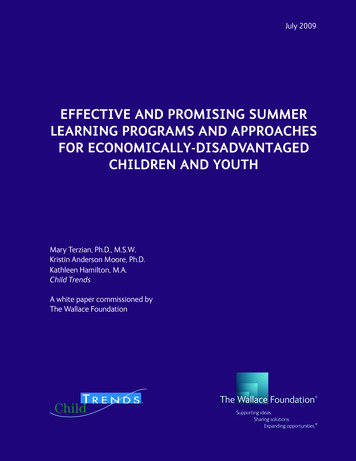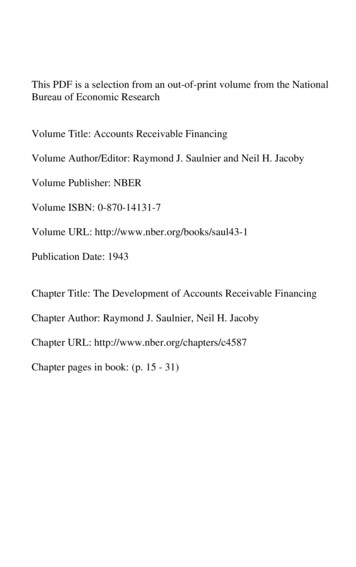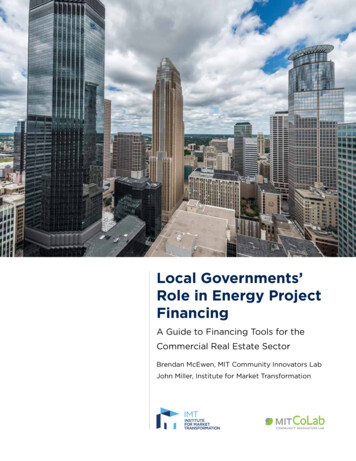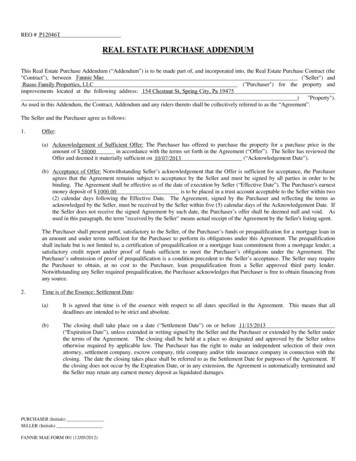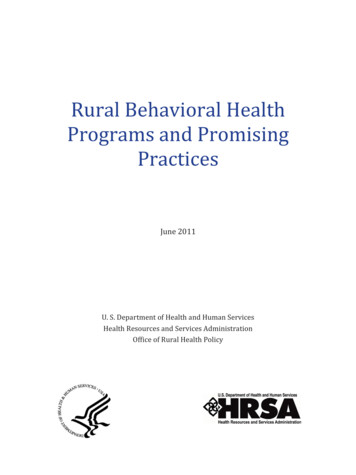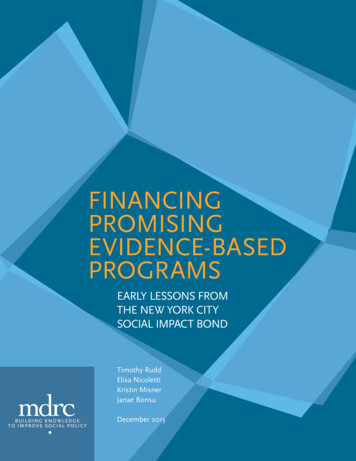
Transcription
FINANCINGPROMISINGEVIDENCE-BASEDPROGRAMSEARLY LESSONS FROMTHE NEW YORK CITYSOCIAL IMPACT BONDTimothy RuddElisa NicolettiKristin MisnerJanae BonsuDecember 2013
Financing Promising Evidence-Based ProgramsEarly Lessons from the New York City Social ImpactBondTimothy Rudd, MDRCElisa Nicoletti, MDRCKristin Misner, NYC Mayor’s OfficeJanae Bonsu, MDRCDecember 2013
This report is made possible through funding from Bloomberg Philanthropies.Dissemination of MDRC publications is supported by the following funders that help financeMDRC’s public policy outreach and expanding efforts to communicate the results and implications of our work to policymakers, practitioners, and others: The Annie E. Casey Foundation,The George Gund Foundation, Sandler Foundation, and The Starr Foundation.In addition, earnings from the MDRC Endowment help sustain our dissemination efforts. Contributors to the MDRC Endowment include Alcoa Foundation, The Ambrose Monell Foundation, Anheuser-Busch Foundation, Bristol-Myers Squibb Foundation, Charles Stewart MottFoundation, Ford Foundation, The George Gund Foundation, The Grable Foundation, TheLizabeth and Frank Newman Charitable Foundation, The New York Times Company Foundation, Jan Nicholson, Paul H. O’Neill Charitable Foundation, John S. Reed, Sandler Foundation,and The Stupski Family Fund, as well as other individual contributors.The findings and conclusions in this report do not necessarily represent the official positions orpolicies of the funders.For information about MDRC and copies of our publications, see our Web site: www.mdrc.org.Copyright 2013 by MDRC . All rights reserved.
OverviewA Social Impact Bond (SIB) relies on initial financing from private investors to produce outcomes governments value. This report describes the first operational SIB in the United Statesand the program financed by it, the Adolescent Behavioral Learning Experience (ABLE).ABLE aims to equip adolescents ages 16 to 18 incarcerated in the New York City jail systemwith the social and emotional skills to help them make better life choices when they leave jail,yielding financial savings to city government by reducing readmissions to Rikers Island. Duringtheir time on Rikers adolescents participate in Moral Reconation Therapy, a cognitive behavioral program designed to help offenders reevaluate their choices and enhance their decisionmaking abilities. Those who leave Rikers before completing the program have the opportunityto resume participation afterward when they return to their communities.Bloomberg Philanthropies and the Urban Investment Group of Goldman Sachs Bank USA areproviding the funding for ABLE: Goldman Sachs provided a loan to pay the cost of operatingthe program, and Bloomberg Philanthropies guaranteed part of the loan amount in the event theprogram is not successful. If the program is successful and meets its benchmarks, the resultingreductions in future incarceration days should save the City of New York money, and the citywill use a part of those savings to pay back the investment. If the program fails to meet the required benchmarks, the city will not achieve any savings and will not pay back the investment.MDRC serves as the intermediary managing the deal, and is responsible for designing the intervention, negotiating and coordinating the financial terms, and overseeing the operations of theABLE program. The Osborne Association and Friends of Island Academy are the service providers delivering the program in Rikers Island jail.The New York City SIB is the first public-private partnership following a Social Impact Bondmodel to involve a large financial institution. It is also the largest implementation of a MoralReconation Therapy program to date. This report attempts to illustrate the merits and challengesof each, and touches on some important lessons that have emerged from these early stages: A committed government partner is especially important to a SIB arrangement. Investors will have more confidence in a SIB if small differences in program performance do not cause sharp distinctions between gaining a return on investment and experiencing a loss. They will also have more confidence in SIBs that incorporate earlyperformance indicators, and in those whose transaction costs are lower. Holding repayment until clear evidence that savings are in fact being achieved increasesthe government partner’s confidence in the effectiveness of the program. Spreading out repayment to align with the value produced by the program increases thegovernment partner’s ability to pay.iii
ContentsOverviewList of ExhibitsPrefaceAcknowledgmentsExecutive viewBackgroundWhat Is a Social Impact Bond?The Structure of This Report2The New York City Deal99101213131517172125273Program Development29293233333536374Implementation Successes, Challenges, and Solutions393939404141The Basic Structure of the DealWorking with GovernmentsIdentifying a Government’s Willingness to PayUnderstanding the Status QuoEstimating Government SavingsThe Number of ParticipantsLength of Program OperationPayment by Impact and the EvaluationWorking with InvestorsFlow of Investment and Repayment for Goldman SachsTakeawaysSelecting the InterventionSelecting a ProviderPilot-Testing the InterventionImplementing the ProgramMonitoring FidelityProject ManagementTakeawaysProgram Enhancements and SuccessesTraining to Increase Correction Officer SupportNew Program Components to Increase Motivation and ParticipationService Delivery ChallengesGroup Size and Components of the Curriculumv
5Participation Rates and DosageParticipation in the JailParticipation in the CommunityTakeaways42424343Revisiting the SIB Idea and Projecting Lessons Learned4545464646474848494950515252525353The Appeal of Social Impact BondsNotable Characteristics of Social Impact BondsGovernment SupportIdentifying a Reasonable Price for Social OutcomesPayment Based on ImpactsDelayed RepaymentLarge-Scale ProgramsOutside InvestmentThe Presence of IntermediariesMaking a Priority of InnovationUnderstanding the Evidence Base and the Role of EvaluationAttracting InvestmentEliminating Sharp Repayment Drop-OffsPerformance Indicators and Quicker Progress AssessmentsReducing Transaction CostsLooking AheadAppendixAMajor Stakeholders in the New York City SIB DealReferences5559vi
List of ExhibitsTableES.1Summary of Payment Terms by ImpactES-82.1Summary of Payment Terms by Impact192.2Expected Impact24FigureES.1Structure of the New York City Social Impact BondES-61.1Project Timeline2.1Structure of the New York City Social Impact Bond112.2Future Jail Bed Use and the Cost of Future Jail Bed Use142.3Program Participation Targets and Contractual Minimums by Year162.4Outcomes and Impacts182.5Applying Evaluation Impacts to Estimate Savings222.6Goldman Sachs Investment and Payback263.1Moral Reconation Therapy (MRT) Freedom Ladder313Box1.1What Is a SIB?6vii
PrefaceGovernments often lack the financial resources to try and expand promising social services. Social Impact Bonds (SIBs) have the potential to overcome that problem by attracting private investment as public risk capital, thereby revealing what does and does not work while improvinggovernment effectiveness and the lives of individuals.In a SIB, private investors finance the cost of operating a promising or innovative socialprogram with the potential to save the government money or achieve some other valued goal —for example, increasing citizens’ productive capacity. If the intervention achieves its desiredoutcomes, the government repays the initial investment plus a return.The SIB concept is still in its earliest stages. Although the first SIB was introduced inthe United Kingdom in 2010, to date the only operational SIB in the United States is the projectdescribed in this report, the New York City SIB, launched in 2012 along with the program financed by it, the Adolescent Behavioral Learning Experience. With financial support from theUrban Investment Group of Goldman Sachs Bank USA and Bloomberg Philanthropies, MDRCpartnered with the City of New York and two nonprofit organizations to provide a large-scaleintervention designed to reduce recidivism among young people in custody at Rikers Island jail.For too many young people, the first time they enter the criminal justice system will notbe the last. In New York City, nearly half of all adolescents incarcerated in Rikers Island jailwill return within one year of being discharged. Incarceration interrupts education, weakensemployment prospects, and puts additional strain on vulnerable young people, families, andcommunities. It is also costly: the City of New York budgets over 1 billion each year to operate its jails. Reducing recidivism among young people would benefit society and government.If an independent evaluator determines that the intervention (a cognitive behavioraltherapy program) reduces recidivism by at least 10 percent, the project will be deemed a successand the Department of Correction will pay back the investors for the cost of operating the program. If that happens, adolescents will have spent less time in jail and the city will have saved asubstantial amount of money over and above the amount of the investment.This project demonstrates that it is feasible to use private capital to finance social programs. In the coming years the concept will be adapted to a number of other policy areas. Earlyprojects may be built around government savings and have high transaction costs, but over timeas governments get better at estimating their willingness to pay, transaction costs should decrease, and SIB arrangements could become more commonplace. To get there from here, how-ix
ever, governments, private investors, philanthropies, and nonprofit service providers will facemany complex issues. It will be essential that the earliest deals be carefully constructed withample due diligence, a pilot period to identify and resolve challenges, and sound research designs to ensure that reliable learning results.Gordon L. BerlinPresidentx
AcknowledgmentsThe New York City Social Impact Bond is made possible by the funding of Bloomberg Philanthropies and financing from the Urban Investment Group of Goldman Sachs Bank USA. Weparticularly thank Katie Appel Duda, James Anderson, Andrea Phillips, Alicia Glen, and DavidGorleku for their effort and support throughout the project.MDRC appreciates the strong partnerships and continued collaboration of the NewYork City Mayor’s Office, the Department of Correction, East River Academy, the Vera Institute of Justice, the Osborne Association, and Friends of Island Academy. We are particularlygrateful to Deputy Mayor for Health and Human Services Linda Gibbs, Correction Commissioner Dora Schriro, Erik Berliner, Jim Parsons, Elizabeth Gaynes, and Christine Pahigan, all ofwhom made time to share their perspectives and experiences with us.We are tremendously thankful to the people who reviewed this report and advised us onit: Gordon Berlin, Dan Bloom, David Butler, John Hutchins, Therese Leung, Brock Grubb,Shane Crary-Ross, and Alice Tufel at MDRC. We are especially thankful to Cindy Redcross atMDRC, who provided guidance and thoughtful, extensive feedback over multiple drafts.Finally, we thank MDRC’s publications staff. Josh Malbin edited the report, and Stephanie Cowell and Carolyn Thomas prepared it for publication.The Authorsxi
Executive SummaryLack of money has long kept promising preventive programs from expanding. Existing government-funded programs are furthermore subject to budgetary cutbacks or complete loss offunding. Moreover, preventive programs traditionally offer no accountability for success orfailure. This leaves government entities in a bind where if they invest their limited funding inpreventive programs that turn out to be ineffective, they end up paying for both the ineffectiveprogram and the services the program was intended to prevent.Social Impact Bonds (SIBs) aim to combat chronic underinvestment in preventive programs while promoting increased accountability. This report details the structure of the NewYork City SIB and the program that it finances, the Adolescent Behavioral Learning Experience(ABLE). Specifically, readers can expect to find answers to the following questions: How didthis project (SIB and ABLE) emerge as a priority in New York City? What exactly is a SIB?How was this SIB structured? What challenges arose in negotiating the financing arrangement?What are the main components of ABLE and what is it trying to accomplish? What have beenthe main accomplishments and challenges in designing and implementing the program? Finally,what has been learned from the project and how can this knowledge be applied to similar initiatives that pay for success?Project BackgroundIn January 2010, Mayor Michael Bloomberg announced a new effort to improve the lives ofyoung black and Latino men, who experience much higher rates of poverty, unemployment, andhomicide than their white and Asian peers. 1 Agencies and thought leaders were charged withfinding ways to make a difference in the lives of these young men, which led to the creation ofthe Young Men’s Initiative (YMI). The YMI focuses on programs and policies designed to improve outcomes for this population in education, health, employment, and the criminal justicesystem.Given that approximately 20 percent of New York City’s black and Latino young menfell within its target age range of 16 to 24, 2 the YMI promised to be a large undertaking requiring a significant amount of funding. During the planning process for the YMI, agencies hadidentified a number of bold ideas that exceeded the total funding available for the YMI initia1David Banks and Ana Oliveira, Young Men’s Initiative: Report to the Mayor from the Chairs (New York:New York City Office of the Mayor, 2011).2New York City Department of City Planning, Total Population by Age, Sex, and Mutually ExclusiveRace, 2010 (New York: New York City Department of City Planning, 2010).ES-1
tive. 3 City leaders then learned about a cutting-edge financing strategy being tried in the UnitedKingdom called a Social Impact Bond.A SIB is a form of “Pay-for-Success” financing in which public and private partnerscollaborate to provide initial private investment support for a public program. Pay-for-Successcontracts base payment to providers on outcomes (for example, achieving a goal related tocommunity job placement or retention) rather than just costs. The concept makes investment ininnovation possible during a period of constrained government funding, because it lessens therisk that taxpayers will pay for ineffective programs. Bloomberg Philanthropies’ governmentinnovation team was exploring the SIB concept and was interested in bringing it to the UnitedStates. The team, focused on spreading proven and promising ideas among cities, saw great potential in this innovative financing model. Bloomberg Philanthropies was also committed to theYMI, and joined the city in efforts to find a YMI effort that could benefit from a SIB.The Office of the Deputy Mayor for Health and Human Services and the governmentinnovation team at Bloomberg Philanthropies reviewed over 40 projects being considered forthe YMI portfolio to determine which fit the SIB criteria. Specifically, they looked for: Services that were largely funded by the city (as opposed to the state or thefederal government), where there could be enough city savings generated topay for a successful program Programs that focused on prevention rather than core services Programs with evidence of success Programs with measurable outcomes Programs that would result in government savings large enough to sustainthe program beyond the funder’s investmentThe New York City Department of Correction (DOC) was interested in implementing alarge-scale program for adolescents incarcerated in Rikers Island jail (Rikers), with the goal ofreducing future recidivism (that is, the rate at which they return to jail in the future) and betterpreparing them for release during their stay. Adolescents incarcerated on Rikers are 91 percentblack and Latino and have a 47 percent chance of returning to jail within one year, making it a3The mayor announced a total funding commitment of 127 million to support YMI work, including 30million from the Open Society Foundation, 30 million from Bloomberg Philanthropies, and up to 67.5 millionfrom the City of New York. ABLE is one of over 40 programs being supported by this funding. See New YorkCity Office of the Mayor, “Mayor Bloomberg Launches Nation’s Most Comprehensive Effort to Tackle Disparities Between Young Black and Latino Males and Their Peers” (news release, August 4, 2011).ES-2
fitting place to focus a YMI program. 4 As the city and Bloomberg Philanthropies identified andevaluated the merits of potential projects across agencies, it became clear that a project onRikers had the most promise to become a SIB. Bloomberg Philanthropies provided funding tosupport the ABLE program, and the SIB was seen as a strategy to expand upon these initialcommitments by attracting private investment.Notable Characteristics of Social Impact BondsThe SIB concept is still very new, and the limited number of actual SIB arrangements makes itdifficult to identify the characteristics that will define SIBs. The idea is likely to evolve in thefuture based on the experiences of its adopters, and as it is adapted to local circumstances. Butsome noteworthy elements of SIBs can already be identified: Committed government partners. Without high-level support from theMayor’s Office and dedicated staff to pursue the idea, the New York CitySIB would not have been possible. Commitment from central, influentialgovernment partners is a major asset for early SIBs, potentially a necessityfor them. Agreement among all parties on the metric for success. Service providers,investors, and government entities must all support a single metric, or therecan be no deal. In the New York City arrangement, the city governmentmade a clear commitment to repay based on a specific measure of success —a reduction in recidivism. That made it possible for all other stakeholders todetermine whether the terms were acceptable. It was essential that the citygovernment knew the cost per day of keeping an adolescent on Rikers Island,and thus what constituted a reasonable price to pay for its desired outcome,keeping adolescents from returning to jail. Payment based on impact. “Impact” refers to the difference between theoutcomes of program participants and the outcomes of a comparison group (asimilar or equivalent population that did not receive the program). Clear andmeasurable outcomes are important in designing a SIB, but by themselvesthey do not prove that programs are making a difference that translates intoreal value for the government. Impacts are a far more useful indicator of success because they provide information about what would have happened toprogram participants if they had not received the program’s services.4New York City Department of Correction, NYC DOC at a Glance (New York: New York City Department of Correction, 2012).ES-3
Withheld repayment. SIBs identify the primary outcome(s) of concern andthen spread repayment over a period of time long enough that a governmententity can make its final payment after a program demonstrates success. Thisprovides the government greater confidence in the effectiveness of the program than is available in the short term. Payments may be further delayed toallow the government entity time to realize the value of the outcomes produced. For instance, in the New York City arrangement repayment was delayed to allow the city government additional time to realize jail savings. Large-scale programs. SIBs may allow promising programs to be implemented at a scale that is not possible without private capital. Depending onthe basis for savings, it may also be necessary for the program to serve alarge number of people in order to reduce costs substantially (especially if agovernment entity is willing to pay more per unit when changes are largethan when changes are small). Outside investment. Outside investment provides the initial funding to expand a program that shows promise. If successful, a SIB provides investorsfinancial returns while achieving public good. The New York City arrangement includes both a commercial investor and a philanthropic one, in a structure designed to ensure that the commercial lender has money at risk at alltimes. The presence of an intermediary. The responsibilities of the intermediaryorganization may vary from deal to deal depending on the experience of theprogram operator, the level of evidence associated with the intervention to beused, and the scale on which it has been employed in the past. In a low-riskdeal involving a program with a large amount of supporting evidence, the intermediary organization would identify funding partners, assist with thestructuring of the SIB, and play a limited role in monitoring program implementation. For a higher-risk deal involving a program with less supportingevidence, an intermediary organization would need finance and negotiationskills and significant experience in program operations, implementation, andevaluation. Robust independent evaluation. Given the risk involved in implementinginnovative approaches at an unprecedented scale, it is imperative that strongand thoughtful evaluation be incorporated into SIB arrangements. Robustevaluation offers proof that the program truly led to the desired difference.ES-4
The New York City Social Impact BondThe New York City SIB relies on a series of interrelated contracts among the following parties: The Urban Investment Group of Goldman Sachs Bank USA, the commercial lender, made a 9.6 million loan to the intermediary for a programthat provides cognitive behavioral therapy services to 16- to 18-year-old adolescents in Rikers Island jail. 5 Bloomberg Philanthropies, the philanthropic investor, provided a 7.2 million grant that will be used to partially repay the commercial lender if theprogram fails. If the program is successful, the grant will be used to supportfuture projects. Bloomberg Philanthropies also provided a separate grant tofund the intermediary’s costs. MDRC, the intermediary, worked with partners to identify the interventionand negotiate the Pay-for-Success terms, hammered out contracts with thevarious partners, and currently oversees the day-to-day implementation of theprogram. The Osborne Association (Osborne) and Friends of Island Academy(Friends), the nonprofit service providers, administer the intervention(ABLE). The City of New York The Mayor’s Office, initiator of the SIB idea, coordinated all other cityentities to structure the contracts, negotiate the terms, and oversee theevaluation. The Department of Correction (DOC), the government payer, agreedto pay the intermediary based on reduced recidivism and the associatedcost savings.The Vera Institute of Justice, the independent evaluator, will determinewhether the project has achieved the intended reductions in recidivism,which will in turn determine repayment.Figure ES.1 illustrates the agreements among the stakeholders in the New York CitySIB and the ABLE program it finances. During their time on Rikers, adolescents participate in5The loan to MDRC was designed by the Goldman Sachs Urban Investment Group and will be made fromGoldman Sachs Bank USA. It is not structured as a program-related investment or foundation grant.ES-5
The New York City Social Impact BondFigure ES.1Structure of the New York City Social Impact BondIntermediaryInvestorsGoldman Sachs,Commerciallender nvestorguarantees loanGovernment 9.6M loanfor programLoan principaland interestpayments 7.2M grant forloan guaranteeMDRCManagesprogram andinvestmentsSuccesspaymentsbased onsavingsNew York CityDepartment ofCorrectionRealizes savingsGrant forintermediarycostsInvestment ( 9.6M) to run programService ProvidersThe OsborneAssociationFriends of IslandAcademyDeliver interventionDecrease in recidivismCognitive behavioral therapy interventionIndependent EvaluatorVera Institute of JusticeMeasures impactAdolescents inRikers Island jailReceive servicesNOTES: The figure illustrates the relationships among the stakeholders in the New York City SocialImpact Bond. Solid lines represent flow of funds, while dotted lines represent activities and services.The evaluation is funded by the Mayor’s Fund to Advance NYC, a nonprofit that promotespartnerships between the city and the private sector to support public programs.ES-6
Moral Reconation Therapy (MRT), a cognitive behavioral treatment designed specifically tohelp offenders reevaluate their choices and enhance their decision-making abilities. Those whoare unable to complete the curriculum while on Rikers have the opportunity to complete it afterward by attending offices in the community run by the nonprofit service providers. If theprogram is successful and meets its predetermined benchmarks, the reductions in incarcerationshould save the City of New York money and the city will then pay back the investment. If theprogram fails to meet the required benchmarks, the city will not achieve any savings and willnot pay back the investment.Repayment to Goldman Sachs will be determined based on two factors: the impact onreadmission bed days (RBDs, also called “future days in jail”) in DOC custody during the twoyears after each young person is released, and the number of participants served over a fouryear period. If the program results in an average reduction in RBDs of at least 10 percent whileserving a certain number of participants, the city will pay back the investor.Table ES.1 shows the potential payments to be made in July 2017 based on 24 monthsof follow-up for the first year’s program participants. A reduction in RBDs of 11 percent ormore will provide a return above the initial investment, and the city will not make a payment ifthe impact is less than 8.5 percent. The Vera Institute of Justice will use a quasi-experimentalevaluation approach to determine the impact of ABLE: a cohort of adolescents incarcerated atRikers during calendar year 2013 will be compared to a historical group that did not receive theprogram. In addition to reducing the rate of readmission, enough participants must benefit thatthe savings cover the program’s cost. While ABLE aims to serve all eligible young people admitted to Rikers, 6 it is not necessary that it do so. For full repayment to occur, the program mustonly serve 9,240 participants within four years (roughly 75 percent of the total projected population).Lessons for Negotiation and ImplementationThe experience of structuring the United States’ first SIB and implementing ABLE has generated the following notable lessons: Strong partnerships are highly valuable in a SIB arrangement. The Cityof New York was a critical partner. In particular, the Mayor’s Office helpedbuild the momentum necessary to secure the support of various city agencies,and the DOC was also a key partner throughout. This arrangement alsobrought together a diverse set of other stakeholders. For successful negotia-6“Eligible young people” includes all adolescents admitted to Rikers between the ages of 16 and 18 whoare in custody long enough to enroll in school.ES-7
The New York City Social Impact BondTable ES.1Summary of Payment Terms by ImpactRecidivismReduction Rate 20.0% 16.0% 13.0% 12.5% 12.0% 11.0% 10.0% 8.5%Department of CorrectionSuccess Payment ( 010,080,0009,600,0004,800,000Net ProjectedTaxpayer Savings ( 700,000 1,000,000 1,000,000SOURCES: MDRC calculations and NYC Task Order.NOTES: The value of the initial loan to operate the program is 9.6 million.In addition to the minimum impacts described above, both success payments are subjectto participation requirements. The program must serve a minimum of 9,420 participantsover the course of its first four years of operation to trigger complete repayment. If feweradolescents are served by the program, then success payments begin to be prorated.Net projected taxpayer savings accounts for the DOC success payment and continuedprogram operation for two additional years (Year 5 and Year 6). Gross taxpayer savings arepurely operational savings within the jail system. A successful program would producemany other social benefits for participants, families, and local communities that are notaccounted for in this agreementʼs definition of success.tions to occur, all parties had to understand each others’ organizational differences, find common ground, and be willing to compromise on individualpreferences in order to reach consensus on important project objectives. To be appropriate for a SIB, an intervention much be supported by evidence, be appropriate for the service environment, and be capable of being expanded to a large scale. Moral Reconation Therapy (MRT) was chosen as the cognitive behavioral treatment in the ABLE program because of itsevidence base and flexibility. Its curriculum is modeled on open groups participants can enter or exit at any time, is self-paced, and documents progress.These features made it expandable and appropriate to the constantly changing population on Rikers. Even so, it was necessary to adapt some elementsof the program (with the permission of the developers) to implement it successfully.ES-8
Ideally, the program should be pilot-tested at full scale. SIBs attract money that allows innovative programs to expand rapidly, but this expansion islikely to come with challenges. It may therefore be desirable to pilot-test aprogram at full scale, and only evaluate it after it achieves a steady state ofoperation. On the
Bloomberg Philanthropies and the Urban Investment Group of Goldman Sachs Bank USA are providing the funding for ABLE: Goldman Sachs provided a loan to pay the cost of operating the program, and Bloomberg Philanthropies guaranteed part of the loan amount in the event the program is not successful.



